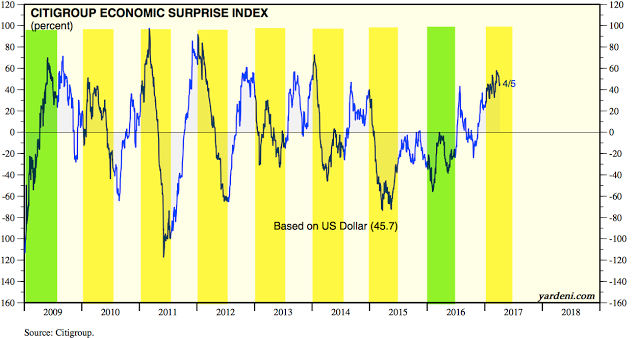Summary: The macro data from the past month continues to mostly point to positive growth. On balance, the evidence suggests the imminent onset of a recession is unlikely.
One concern in recent months had been housing, but revised data shows housing starts breaking above the flattening level that has existed over the past two years. A resumption in growth appears to be starting.
That leaves employment growth as the main watch out: employment growth is decelerating, from over 2% last year to 1.5% now. It's not alarming but it is noteworthy that expansions weaken before they end, and slowing employment growth is a sign of some weakening that bears monitoring.
A second watch out is demand growth. Real retail sales excluding gas is in a decelerating trend. In February, growth was just 1.8%. Personal consumption accounts for about 70% of GDP so weakening retail sales bears watching closely.
Overall, the main positives from the recent data are in employment, consumption growth and housing:
- Monthly employment gains have averaged 178,000 during the past year, with annual growth of 1.5% yoy. Full-time employment is leading.
- Recent compensation growth is among the highest in the past 8 years: 2.7% yoy in March.
- Most measures of demand show 2-3% real growth. Real personal consumption growth in February was 2.6%. Real retail sales (including gas) grew 2.8% yoy in February.
- Housing sales grew 13% yoy in February. Starts grew 6% over the past year.
- The core inflation rate is ticking higher but remains near the Fed's 2% target.
The main negatives are concentrated in the manufacturing sector (which accounts for less than 10% of employment):
- Core durable goods growth rose 3.4% yoy in February. It was weak during the winter of 2015-16 and is slowly rebounding in recent months.
- Industrial production has also been weak; it's flat yoy due to weakness in mining (oil and coal). The manufacturing component grew 1.4% yoy in February.
Prior macro posts are here.
* * *
Our key message over the past 4 years has been that (a) growth is positive but slow, in the range of ~2-3% (real), and; (b) current growth is lower than in prior periods of economic expansion and a return to 1980s or 1990s style growth does not appear likely.
Modest growth should not be a surprise. This is the typical pattern in the years following a financial crisis like the one experienced in 2008-09.
This is germane to equity markets in that macro growth drives corporate revenue, profit expansion and valuation levels. The saying that "the stock market is not the economy" is true on a day-to-day or even month-to-month basis, but over time these two move together. When they diverge, it is normally a function of emotion, whether measured in valuation premiums/discounts or sentiment extremes (enlarge any image by clicking on it).
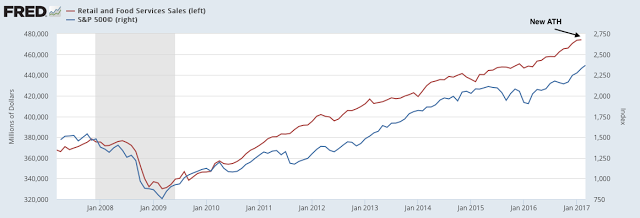
A valuable post on using macro data to improve trend following investment strategies can be found here.
Let's review each of these points in turn. We'll focus on four macro categories: labor market, inflation, end-demand and housing.
Employment and Wages
The March non-farm payroll was 98,000 new employees minus 38,000 in revisions. In the past 12 months, the average monthly gain in employment was 178,000. Employment growth is decelerating.
Monthly NFP prints are normally volatile. Since 2004, NFP prints near 300,000 have been followed by ones near or under 100,000. That has been a pattern during every bull market; NFP was negative in 1993, 1995, 1996 and 1997. The low print of 98,000 this month, 84,000 in March 2015 and 24,000 in May 2016 fit the historical pattern. This is normal, not unusual or unexpected.

Why is there so much volatility? Leave aside the data collection, seasonal adjustment and weather issues; appreciate that a "beat" or a "miss" of 80,000 workers in a monthly NFP report is equal to just 0.05% of the US workforce.
For this reason, it's better to look at the trend; in March, trend employment growth was 1.5% yoy. Until spring 2016, annual growth had been over 2%, the highest since the 1990s. Ahead of a recession, employment growth normally falls (arrows). Continued deceleration in employment growth in the coming months continues to be a critical watch out.
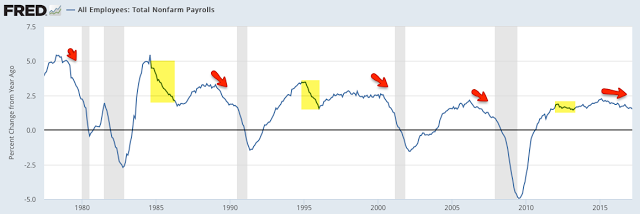
Employment has been been driven by full-time jobs, which are at a new all-time high (blue line), not part-time jobs (red line).

The labor force participation rate (the percentage of the population over 16 that is either working or looking for work) had been falling but has more recently stabilized. The overall trend down has little to do with the current recovery; the participation rate has been falling for more than 17 years. Participation is falling as baby boomers retire, exactly as participation started to rise in the mid-1960s as this group entered the workforce. Another driver is women, whose participation rate increased from about 30% in the 1950s to a peak of 60% in 1999.
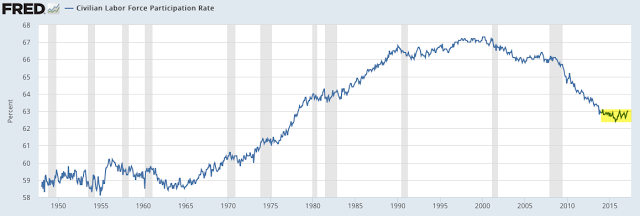
Average hourly earnings growth was 2.7% yoy in March, among the highest growth rates in the past 8 years. This is a positive trend, showing demand for more workers. Sustained acceleration in wages would be a big positive for consumption and investment that would further fuel employment.
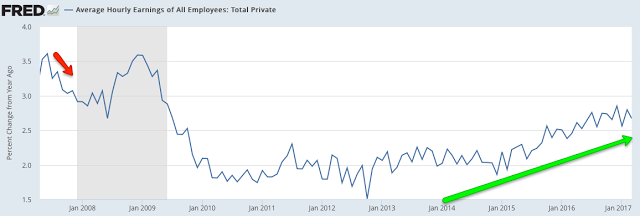
Similarly, 4Q16 employment cost index shows compensation growth was 2.3% yoy. This is near the highest growth rate since the recession.

For those who doubt the accuracy of the BLS employment data, federal tax receipts have also been rising to new highs (red line), a sign of better employment and wages (from Yardeni).

Inflation
Despite steady employment growth, inflation remains stuck near the Fed's target of 2%. But note: CPI and PCE are finally ticking higher.
CPI (blue line) was 2.8% last month, the third month in a row it has been over 2% (last time was June 2014). The more important core CPI (excluding volatile food and energy; red line) grew 2.2%, among the highest levels since 2008 although still just oscillating near 2%.

The Fed prefers to use personal consumption expenditures (PCE) to measure inflation; total and core PCE were 2.1% and 1.8% yoy, respectively, last month. February was the first month since 2Q 2012 that total PCE was above 2%.

For some reason, many mistrust CPI and PCE. MIT publishes an independent price index (called the billion prices index; yellow line). It has tracked both CPI (blue line) and PCE closely.
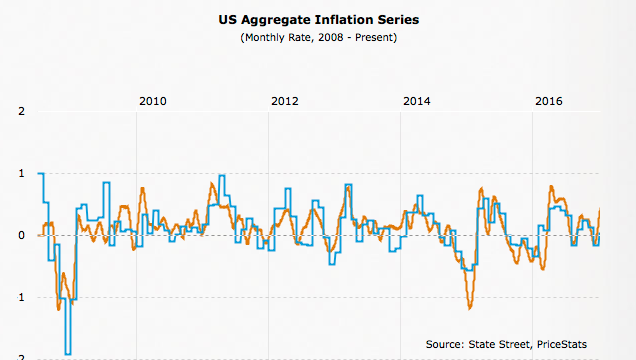
Demand
Regardless of which data is used, real demand has been growing at about 2-3%, equal to about 4-5% nominal. One concern is real retail sales growth: excluding gas, growth has decelerated to under 2%.
Real (inflation adjusted) GDP growth through 4Q16 was 2.0% yoy. 2.5-5% was common during prior expansionary periods prior to 2006.
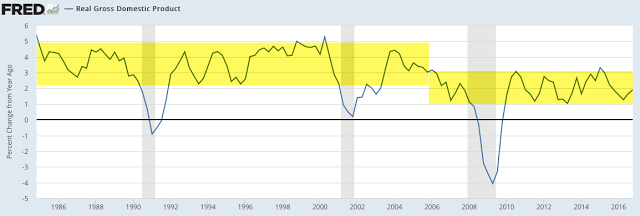
Stripping out the changes in GDP due to inventory produces "real final sales". This is a better measure of consumption growth than total GDP. In 4Q16, this grew 2.0% yoy. A sustained break above 2.5% would be noteworthy.

The "real personal consumption expenditures" component of GDP (defined), which accounts for about 70% of GDP, grew at 3.1% yoy in 4Q16. This is approaching the 3-5% that was common in prior expansionary periods after 1980.

On a monthly basis, the growth in real personal consumption expenditures was 2.6% yoy in February.

GDP measures the total expenditures in the economy. An alternative measure is GDI (gross domestic income), which measures the total income in the economy. Since every expenditure produces income, these are equivalent measurements of the economy. A growing body of research suggests that GDI might be more accurate than GDP (here).
Real GDI growth in 4Q16 was 1.9% yoy.

Real retail sales reached a new all-time high in January; in February, annual growth was 2.8% yoy. The range has generally been centered around 2.5% yoy for most of the past 20 years.
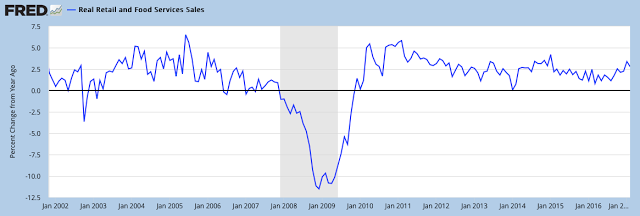
Retail sales in the past two years have been strongly affected by the large fall in the price of gasoline. In February, real retail sales at gasoline stations rose by 16% yoy after having fallen more than 20% yoy earlier in 2016. Real retail sales excluding gas stations grew 1.8% in February. This is a weakening trend.

The main negatives in the macro data have been concentrated in the manufacturing sector, as the next several slides show. It's important to note that manufacturing accounts for less than 10% of US employment, so these measures are of lesser importance. Even within manufacturing, the weakness is concentrated; most sectors are not contracting (more on this here).
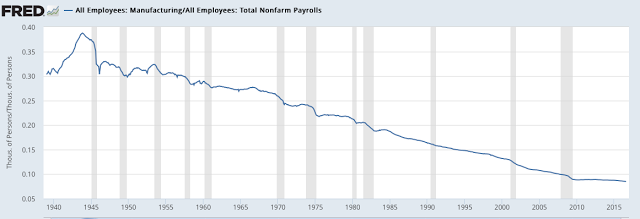
Core durable goods orders (excluding military, so that it measures consumption, and transportation, which is highly volatile) rose 3.4% yoy (nominal) in February. Weakness in durable goods has not been a useful predictor of broader economic weakness in the past (arrows).

Industrial production growth was 0.3% yoy in February. The more important manufacturing component (excluding mining and oil/gas extraction; red line) rose 1.4% yoy. This is a volatile series: manufacturing growth was lower at points in both 2013 and 2014 than it was in 2016 before rebounding strongly.

Weakness in total industrial production has been concentrated in the mining sector, which rose 1.8% yoy in February; the past two years have had the worst annual fall in more than 40 years. It is not unusual for this part of industrial production to plummet outside of recessions. 
Housing
Housing sales grew 13% yoy in February. Housing starts in February were at the second highest level in 10 years. Overall levels of construction and sales are small relative to prior bull markets but the trend is higher.
First, new houses sold was 592,000 in February, the second highest level in the past 9 years. Growth was 13% over the past year after falling 4% yoy in February 2016.
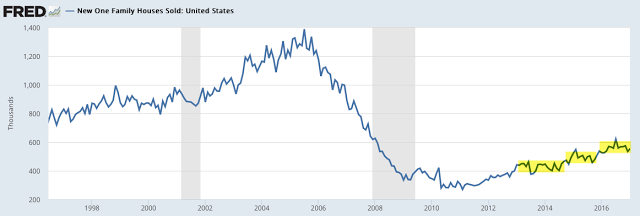
Second, overall housing starts in February were at the second highest level since August 2007 and 6% higher than a year ago. Importantly, revised data shows housing starts breaking above the flattening level that has existed over the past two years. A resumption in growth may be beginning.
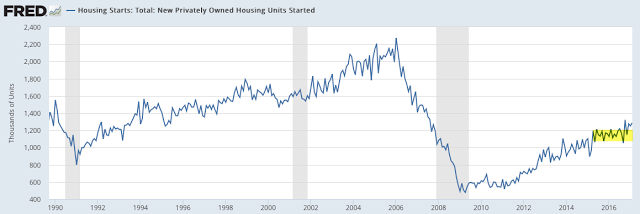
Building permits have been on an improving trend since March 2016, growing 4% in the past year (red line). The trend is flat over the past two years, however.
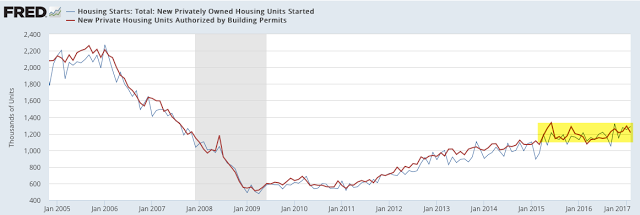
Single family housing starts (blue line) reached a new post-recession high in February. Multi-unit housing starts (red line) are flat over the past four years; this has been a drag on overall starts.
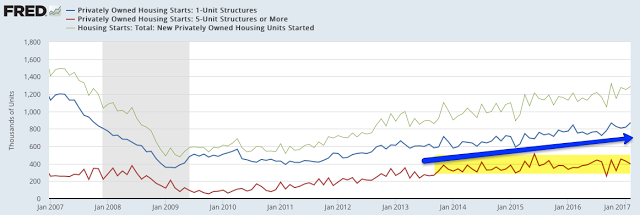
Summary
In summary, the major macro data so far suggest positive, but slow, growth. This is consistent with corporate sales growth. SPX sales growth in 2017 is expected to only about 5% (nominal).
With valuations now well above average, the current pace of growth is likely to be the limiting factor for equity appreciation. This is important, as the consensus expects earnings to grow about 10% in 2017 (chart from Yardeni).

Modest growth should not be a surprise. This is the classic pattern in the years following a financial crisis like the one experienced in 2008-09. Unlike typical cyclical expansions, consumers have reduced their relative debt, and this has constrained their consumption.
Macro data is ahead of expectations to start the year. During the current expansion, that has led to underperformance of macro data relative to expectations as the year progresses (yellow shading). 2009 and 2016 were the exceptions as these years began with macro data underperforming expectations and then beating expectations as the years progressed (green shading).
